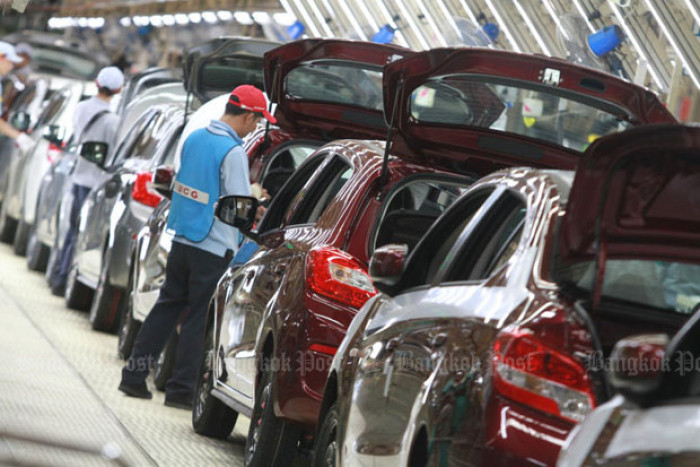Auto market dynamics are constantly evolving, shaped by trends that reflect both technological advances and changing consumer preferences. As the industry adapts, emerging technologies like electric vehicles are becoming increasingly popular, driven by a demographic shift towards more eco-conscious choices. Economic factors also play a crucial role, influencing everything from vehicle production to sales figures.
This transformation is not just about what cars are being produced, but also about how buyers are making their choices. The landscape of vehicle purchasing is becoming more complex, with consumers now weighing factors such as sustainability and technological innovation heavily in their decisions.
Market Trends

The automotive market is currently undergoing significant transformations driven by a variety of factors that include technological advancements, shifting consumer preferences, and economic conditions. As the industry evolves, understanding these market trends becomes crucial for stakeholders, from manufacturers to consumers. Recent data indicates that the integration of advanced technologies is reshaping the way vehicles are designed, marketed, and sold, influencing not just production but also consumer buying habits.Emerging technologies play a pivotal role in shaping consumer preferences, with a marked shift towards electric vehicles (EVs), autonomous driving features, and enhanced connectivity.
The Land Rover Defender 110 stands out with its robust design and off-road capabilities, making it the perfect companion for adventure seekers. Its spacious interior and advanced technology ensure comfort without compromising performance. Whether tackling rugged terrains or navigating city streets, this vehicle proves to be both versatile and powerful.
The demand for eco-friendly alternatives has surged, emphasizing the need for manufacturers to adapt to changing consumer values.
Technological Innovations Impacting Consumer Preferences
The integration of new technologies in the automotive sector has significantly altered consumer expectations. Key innovations include:
- Electric Vehicles (EVs): The acceleration of EV adoption is evident, with major manufacturers committing to electric lineups. Companies like Tesla have paved the way, and traditional automakers are following suit with extensive EV portfolios.
- Autonomous Driving: The investment in self-driving technology continues to rise, with companies like Waymo and Ford leading testing initiatives. The prospect of safer and more efficient transportation is reshaping consumer interest.
- Connected Cars: Vehicles equipped with advanced infotainment systems, IoT connectivity, and over-the-air updates are becoming increasingly appealing. They enhance user experience and provide greater control, which consumers are beginning to prioritize.
The impact of these technological advancements is profound, leading consumers to seek vehicles that not only meet their mobility needs but also align with their values regarding sustainability and innovation.
Economic Factors Influencing Vehicle Sales and Production
Economic conditions significantly affect the automotive sector, influencing both vehicle sales and production rates. Factors to consider include:
- Interest Rates: Fluctuating interest rates can impact consumers’ financing options, making it more or less attractive to purchase new vehicles. Higher rates often lead to decreased sales as affordability diminishes.
- Raw Material Costs: The cost of essential materials, such as steel and lithium for batteries, directly affects production costs. Price increases can lead to higher retail prices, which may deter potential buyers.
- Supply Chain Disruptions: The COVID-19 pandemic highlighted vulnerabilities in global supply chains. Ongoing challenges, including semiconductor shortages, continue to impede production schedules and influence inventory levels.
Understanding these economic factors is crucial for anticipating market dynamics and aligning production strategies with consumer demand. As the industry navigates these challenges, stakeholders must remain agile to adapt to the ever-evolving landscape of the automotive market.
If you’re looking for a compact car that doesn’t skimp on style and performance, the Volvo C30 is an excellent choice. With its distinctive hatchback design and emphasis on safety, this model blends sporty aesthetics with practicality. Ideal for urban driving, it also offers a unique character that sets it apart in a crowded market.
Consumer Behavior
Recent years have witnessed significant shifts in consumer preferences within the auto market. A combination of technological advancements, evolving environmental concerns, and changing lifestyles has influenced how consumers approach vehicle ownership and selection. As a result, the automotive industry’s landscape is being reshaped by these broader sociocultural dynamics, particularly as they pertain to environmental responsibility and the quest for innovation.One of the most notable trends is the increasing inclination towards electric vehicles (EVs) over traditional gasoline-powered cars.
This shift is driven by several key factors that have changed consumer attitudes and priorities. Firstly, the growing awareness of climate change and its impacts has propelled consumers to consider the ecological footprint of their transportation choices. Secondly, advancements in EV technology have improved performance and reduced costs, making these vehicles more appealing. Additionally, government incentives and rising fuel prices have further nudged consumers toward greener alternatives.
Factors Driving the Shift to Electric Vehicles, Auto market
A variety of elements contribute to the rising popularity of electric vehicles, each playing a significant role in reshaping consumer behavior in the auto market.
- Environmental Concerns: Consumers are increasingly motivated by sustainability, seeking out vehicles that minimize their carbon footprints. This growing consciousness is enhanced by campaigns promoting cleaner air and reduced greenhouse gas emissions.
- Economic Incentives: Government subsidies, tax breaks, and incentives for purchasing electric vehicles have made them financially attractive options. This financial assistance encourages many consumers to opt for EVs instead of traditional vehicles.
- Technological Advancements: Improvements in battery technology, charging infrastructure, and vehicle range have alleviated many concerns associated with electric vehicles. Enhanced performance metrics, such as acceleration and convenience of charging, have made EVs more desirable.
- Rising Fuel Prices: The volatility of gasoline prices often influences consumer purchasing decisions. As fuel prices rise, consumers are more inclined to consider alternatives that promise lower operational costs, such as electric vehicles.
- Shift in Lifestyle Preferences: Younger consumers, particularly millennials and Gen Z, are showing a preference for sustainable living and innovation, pushing automakers to prioritize electric and hybrid models. This demographic values eco-friendly products and is more likely to engage with brands that align with their values.
Demographic Purchasing Habits in the Auto Market
Consumer behavior in the auto market varies significantly across different demographics, reflecting diverse values, preferences, and purchasing power among groups. Understanding these differences is crucial for automakers aiming to tailor their marketing strategies effectively.
- Millennials: This demographic tends to prioritize technology and sustainability in their purchasing decisions. They are more likely to embrace electric vehicles and connected car technologies, valuing features such as driver-assistance systems and in-car connectivity.
- Generation Z: This group shows a strong inclination towards sustainability and social responsibility. They often prefer brands that are transparent about their environmental impact and may favor public transportation or shared mobility options over traditional vehicle ownership.
- Baby Boomers: While they may be less inclined to shift to electric vehicles compared to younger generations, many in this demographic prioritize reliability and comfort. As they age, safety features become increasingly important, influencing their vehicle choices.
- High-Income Consumers: Wealthier buyers are often early adopters of new technologies, including electric vehicles. They are typically more willing to invest in luxury EV models, seeing them as status symbols that also promote sustainability.
- Low-Income Consumers: This demographic might face barriers to adopting electric vehicles, primarily due to higher upfront costs and limited access to charging infrastructure. Financial considerations heavily influence their choices, often leading them to opt for used vehicles or more affordable gasoline-powered models.
Competitive Landscape

The competitive landscape of the auto market is a dynamic and multifaceted environment, shaped by the strategies and actions of various key players. Understanding the primary competitors and their respective market shares provides insight into the market structure and the tactics employed to secure a competitive edge. This analysis will highlight leading manufacturers and the transformative partnerships that significantly impact competition within the industry.
Primary Competitors and Market Shares
The auto market is dominated by several major players, each vying for market share through innovation and strategic positioning. The following Artikel presents the leading competitors and their estimated global market shares:
- Toyota: Continues to lead the market with approximately 10% global share, renowned for its reliability and hybrid technology.
- Volkswagen Group: With around 8% market share, Volkswagen has made significant strides in electric vehicle (EV) development.
- General Motors: Holding about 7% of the market, GM focuses on both traditional combustion engines and electric models.
- Ford: Capturing roughly 6% of the market, Ford is rapidly expanding its EV lineup while maintaining strong truck sales.
- BMW: Known for luxury and performance, BMW holds about 4% of the market, emphasizing premium features and electric tech.
These market shares reflect a combination of traditional vehicle sales and the growing influence of electric vehicles, highlighting the necessity for manufacturers to adapt to changing consumer preferences.
Strategies Employed by Successful Manufacturers
Successful auto manufacturers implement a variety of strategies to gain market advantage, focusing on innovation, customer engagement, and sustainability. These strategies include:
- Investment in Electric Vehicles: Major manufacturers are allocating significant resources towards EV development, reflecting a shift in consumer preferences and regulatory pressures.
- Emphasis on Connected Technology: Integrating advanced telematics and driver-assistance systems enhances the consumer experience and sets brands apart.
- Agile Manufacturing Techniques: Adopting lean manufacturing principles enables quicker responses to market demands and reduces production costs.
- Direct-to-Consumer Sales Models: Companies like Tesla have revolutionized sales processes by engaging customers directly, bypassing traditional dealership networks.
These strategies underline the importance of innovation and responsiveness in maintaining a competitive edge in the ever-evolving auto market.
Key Partnerships and Collaborations
Partnerships and collaborations play a crucial role in shaping competition within the auto industry. The following are notable collaborations that have significantly influenced market dynamics:
- Ford and Google: This partnership leverages Google’s cloud computing capabilities to enhance Ford’s in-car technology and data analytics.
- BMW and Daimler: Collaborating on mobility services, this alliance aims to streamline user experiences in urban transportation.
- Volkswagen and Ford: Both companies entered a strategic alliance to co-develop electric and autonomous vehicles, sharing technologies and reducing costs.
- Mercedes-Benz and NVIDIA: Partnering to develop AI and automated driving technologies, enhancing their competitive position in the future of mobility.
These strategic alliances illustrate how key players in the auto market are adapting to technological advancements and consumer demands, ultimately transforming the competitive landscape.
Sustainability Practices: Auto Market
The role of sustainability in the automotive market has rapidly evolved, becoming a critical factor in shaping consumer preferences and business strategies. As environmental consciousness rises globally, automotive manufacturers are increasingly recognizing the importance of adopting sustainable practices to minimize their environmental impact and enhance brand loyalty. These initiatives not only align with regulatory requirements but also meet the growing demand for greener, more efficient vehicles.Sustainability is instrumental in reshaping the future of the auto market.
It drives innovation in electric and hybrid vehicle development, promotes the use of renewable energy sources, and encourages manufacturers to implement eco-friendly production processes. The shift towards sustainability also influences the entire supply chain, necessitating a collaborative approach among suppliers, manufacturers, and customers to create a more sustainable ecosystem.
Best Practices for Eco-Friendly Production Processes
To successfully implement sustainability in production, auto manufacturers can adopt several best practices. These methods not only reduce the environmental footprint of manufacturing but also enhance operational efficiency and cost savings. Key practices include:
- Utilization of Renewable Energy: Transitioning to renewable energy sources such as solar or wind power for manufacturing facilities significantly reduces greenhouse gas emissions.
- Recycling and Reusing Materials: Implementing systems for recycling materials like metals, plastics, and textiles can minimize waste and lower raw material costs.
- Water Conservation Techniques: Employing water-efficient processes in manufacturing and utilizing rainwater harvesting systems can substantially reduce water consumption.
- Lean Manufacturing Principles: Adopting lean production techniques helps minimize waste and enhances overall efficiency in the manufacturing process.
- Life Cycle Assessment: Conducting life cycle assessments to evaluate the environmental impact of vehicles from production to disposal ensures that sustainability is considered at every stage of the product life cycle.
Leading automotive companies have successfully implemented sustainability initiatives that serve as models for the industry. Notable examples include:
- Tesla: As a pioneer in electric vehicles, Tesla emphasizes sustainable energy use across its operations. The company’s Gigafactory aims to produce batteries with minimal environmental impact, achieving a closed-loop recycling process for battery materials.
- BMW: BMW has committed to using 100% renewable energy in its production plants. The company has also introduced a strategy called “Circular Economy,” which focuses on designing vehicles that are easy to recycle and reuse components.
- Ford: Ford’s “Sustainable Blue Oval” plan includes aspirations to achieve carbon neutrality globally by 2050. The company has invested in sustainable materials, incorporating recycled plastics into various vehicle components.
- Volkswagen: Volkswagen’s “Together – Strategy 2025” plan emphasizes electric vehicle production while aiming to achieve a 30% reduction in CO2 emissions per vehicle by 2025 through cleaner production processes.
“Sustainability is no longer an option; it is a necessity for modern automotive manufacturers as we shift towards a greener future.”
Regulatory Environment
The regulatory landscape of the automotive industry is evolving rapidly, influenced by a range of factors from environmental concerns to technological advancements. Key regulations are not only shaping vehicle design and production processes but are also driving manufacturers to innovate in response to new compliance demands. This section delves into the essential regulations impacting the auto market, the implications of emissions standards, and how government policies are paving the way for innovation.
Key Regulations Affecting the Auto Market
The automotive industry is governed by a myriad of regulations aimed at ensuring safety, environmental protection, and consumer rights. Understanding these regulations is crucial for manufacturers to remain compliant and competitive.
- Safety Standards: Regulations like the Federal Motor Vehicle Safety Standards (FMVSS) in the U.S. enforce stringent safety requirements for vehicles, impacting design and manufacturing processes.
- Environmental Regulations: The Clean Air Act and similar laws impose limits on vehicle emissions, requiring manufacturers to develop cleaner technologies.
- Consumer Protection Laws: Regulations ensuring transparency in vehicle sales and warranties protect consumer interests and affect marketing strategies.
Impact of Emissions Standards on Vehicle Production
Emissions standards play a pivotal role in shaping the production of vehicles. These regulations are designed to limit the amount of pollutants that vehicles can emit, compelling manufacturers to innovate continuously.
“The future of automotive design hinges on meeting strict emissions targets set by regulatory bodies globally.”
The following factors highlight the impact of emissions standards on vehicle production:
- Technological Investments: Manufacturers are investing heavily in research and development for electric vehicles (EVs) and hybrid technologies to comply with stringent emissions regulations.
- Supply Chain Adjustments: Emissions standards are prompting changes in supply chains, with a greater focus on sourcing materials that enable the production of lower-emission vehicles.
- Market Demand Shift: Increased consumer awareness regarding emissions has shifted demand toward eco-friendly vehicles, influencing production strategies.
Evolving Government Policies Driving Innovation
Governments worldwide are implementing policies that not only regulate but also encourage innovation within the automotive sector. These policies aim to support sustainable growth and technological advancements.
“Government incentives are transforming the auto industry, pushing manufacturers toward innovative solutions.”
Key aspects of these evolving policies include:
- Incentives for Electric Vehicles: Policies that offer tax credits and rebates for EV purchases are bolstering the market for electric cars.
- Investment in Infrastructure: Governments are investing in charging infrastructure that supports the growth of electric and hybrid vehicles.
- Research Grants: Funding for research initiatives focusing on sustainable technologies encourages companies to explore groundbreaking solutions.




